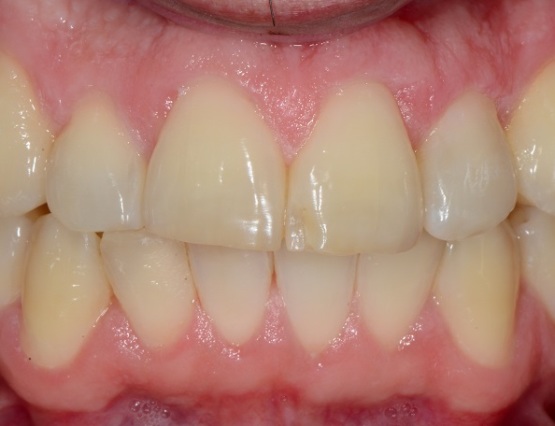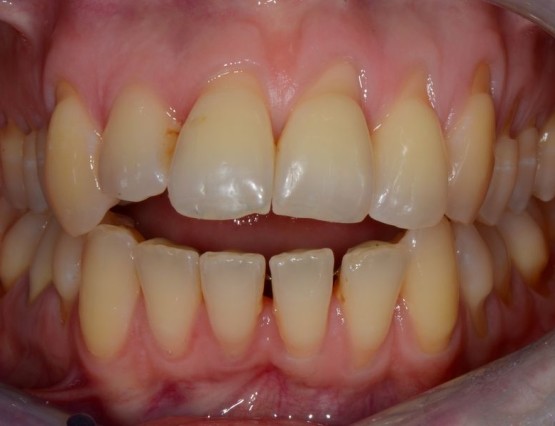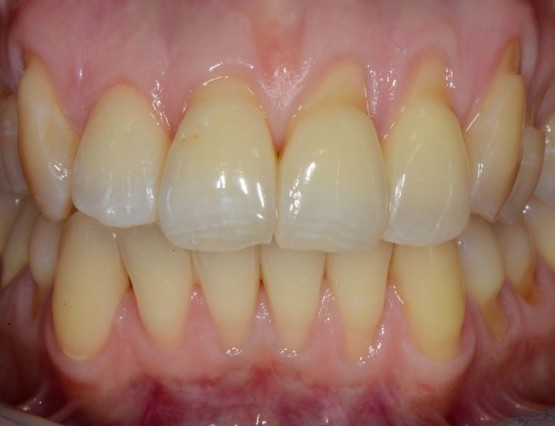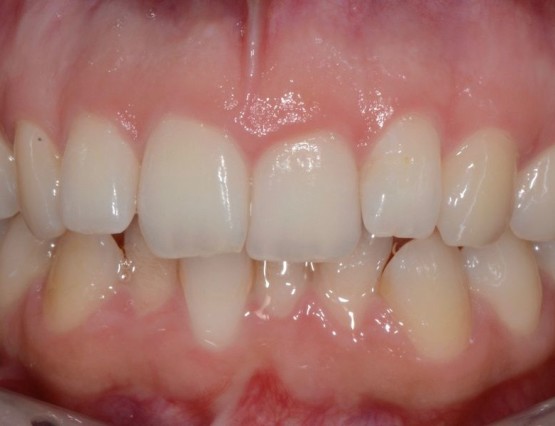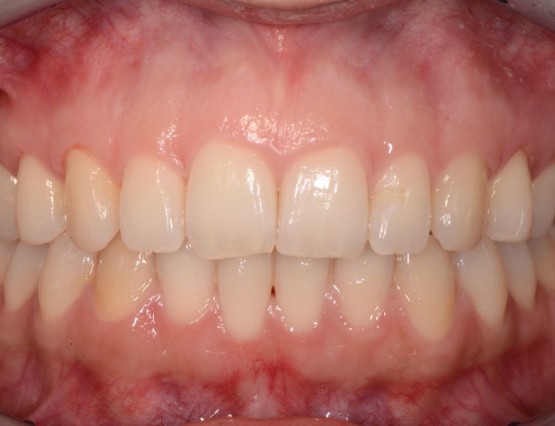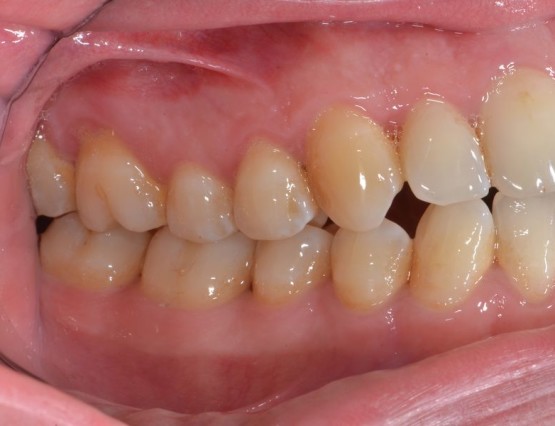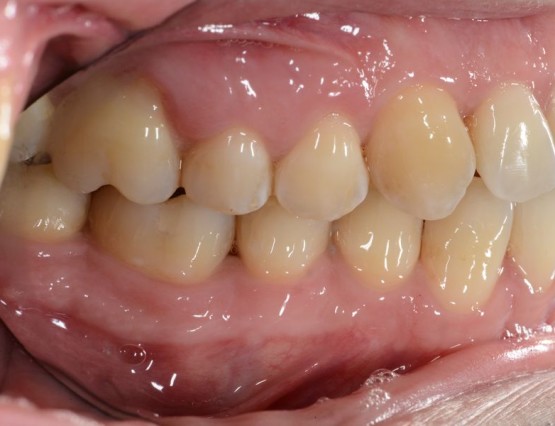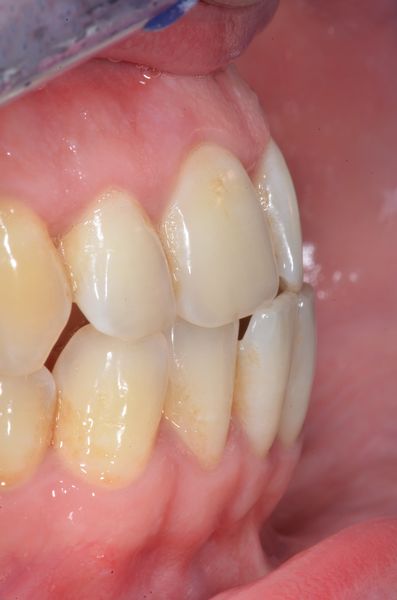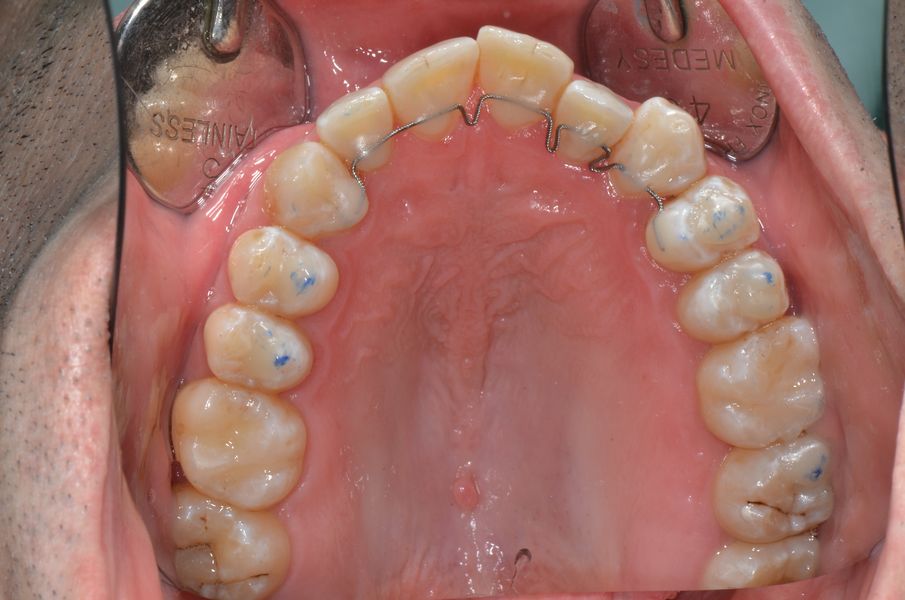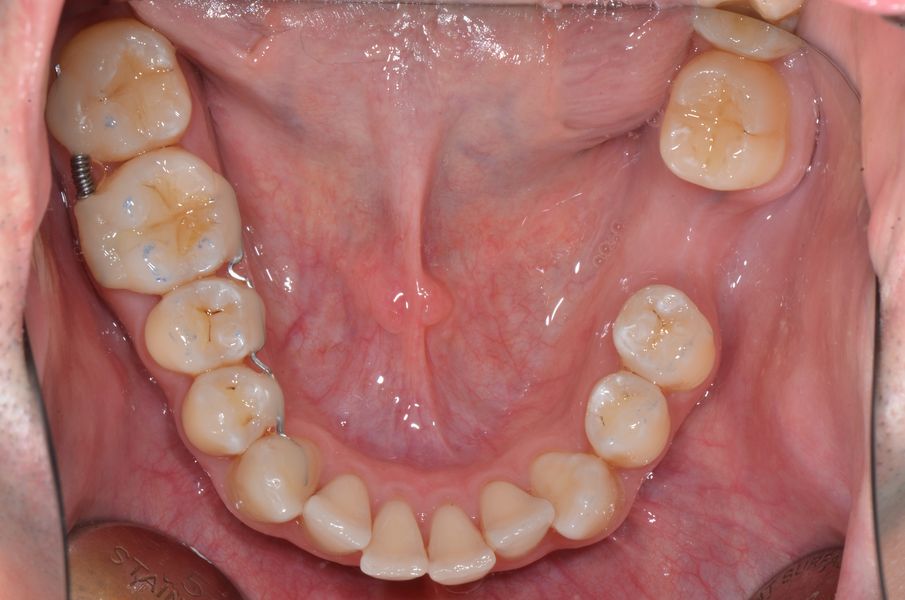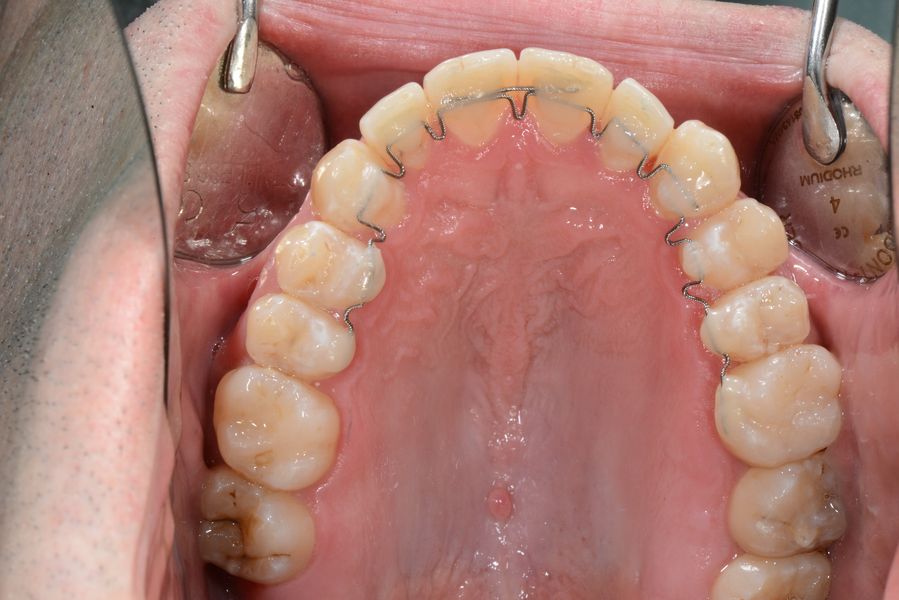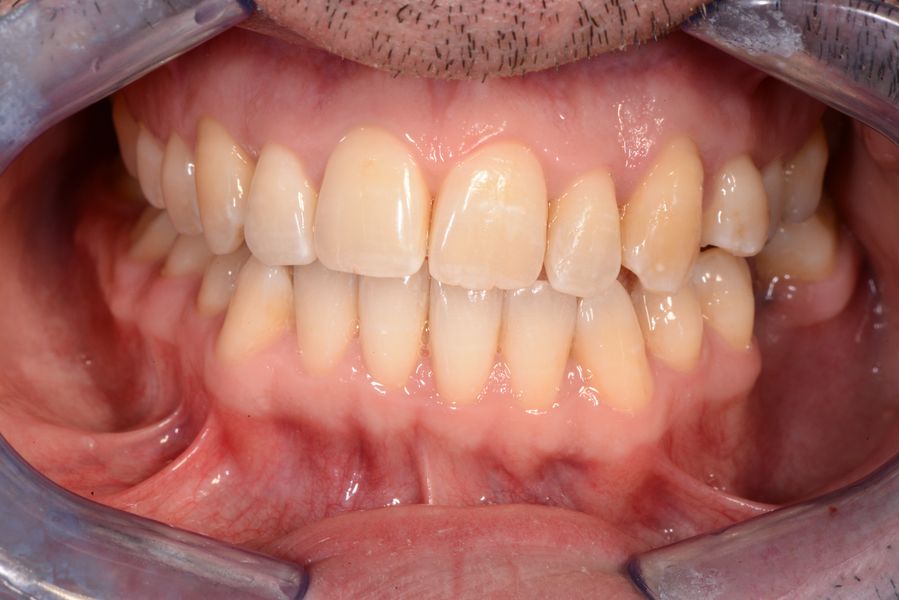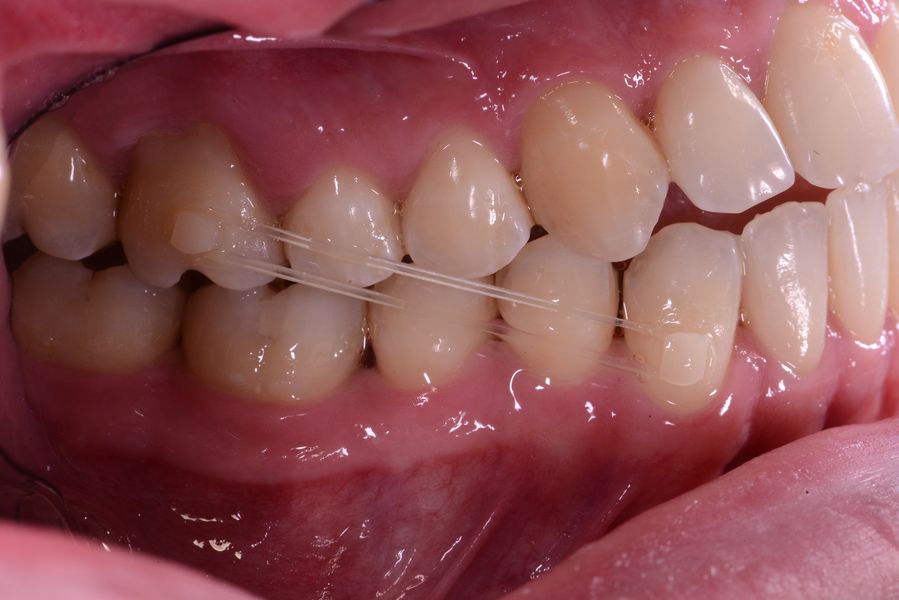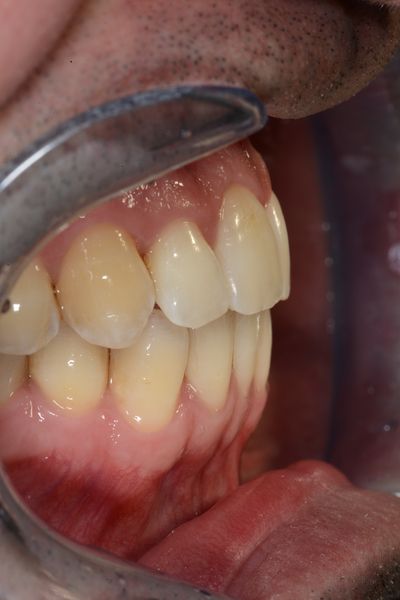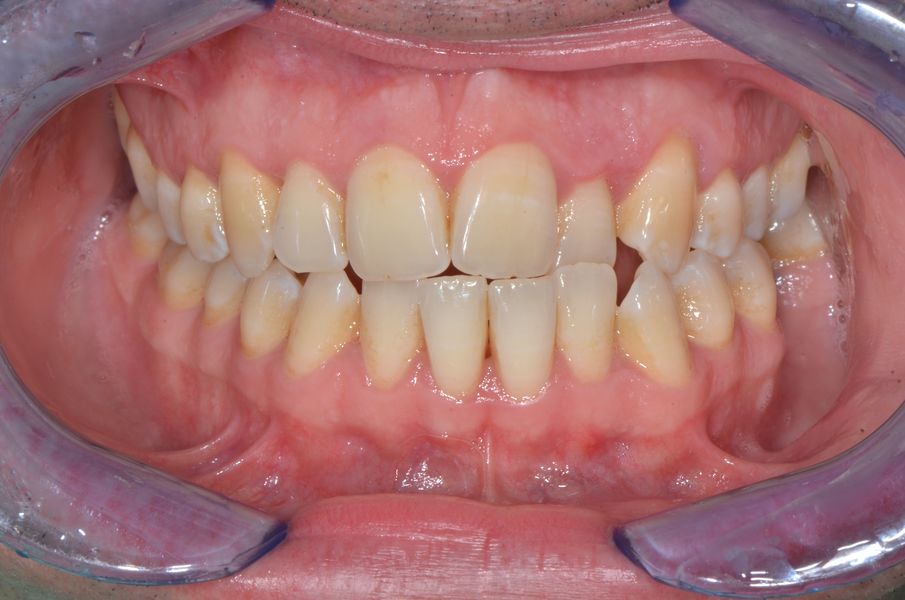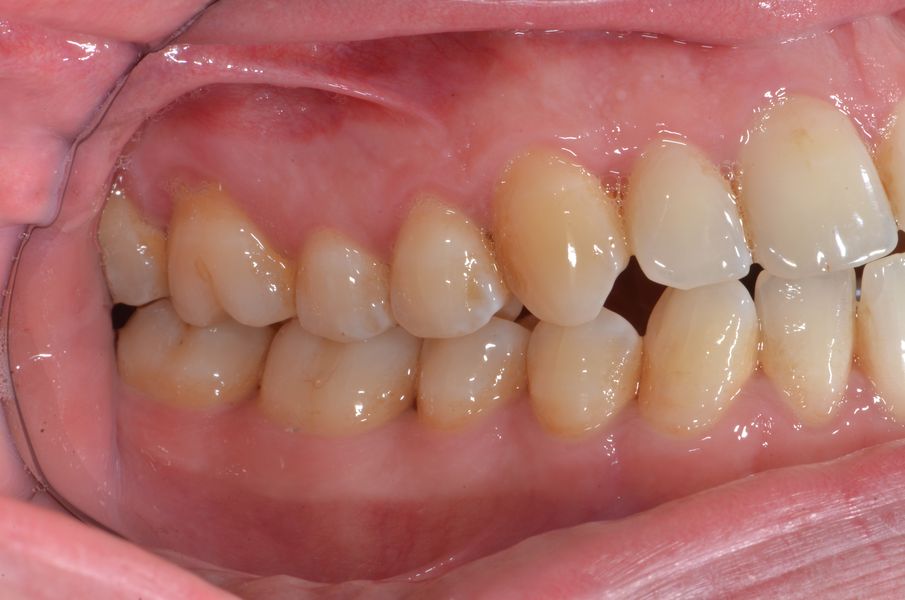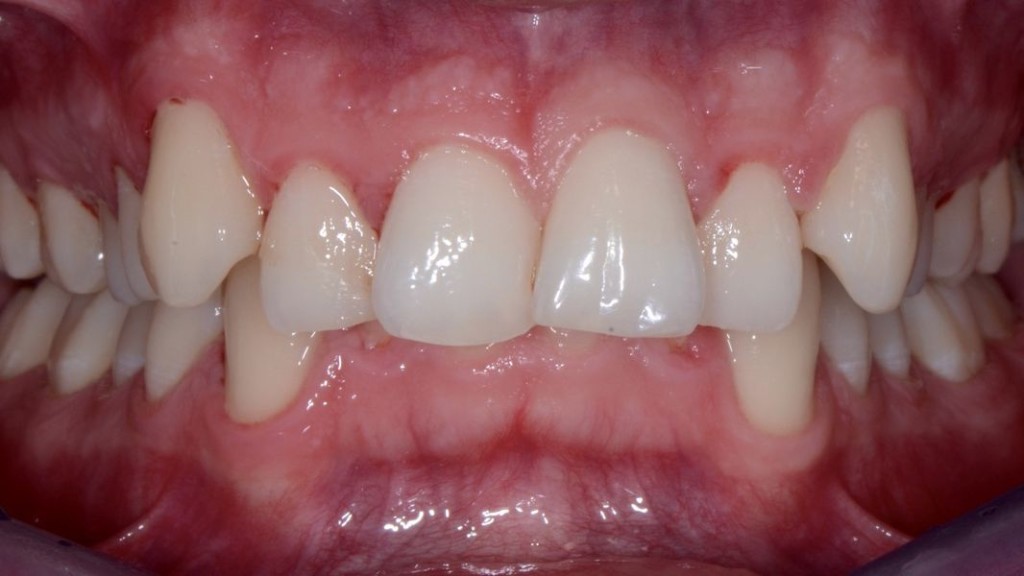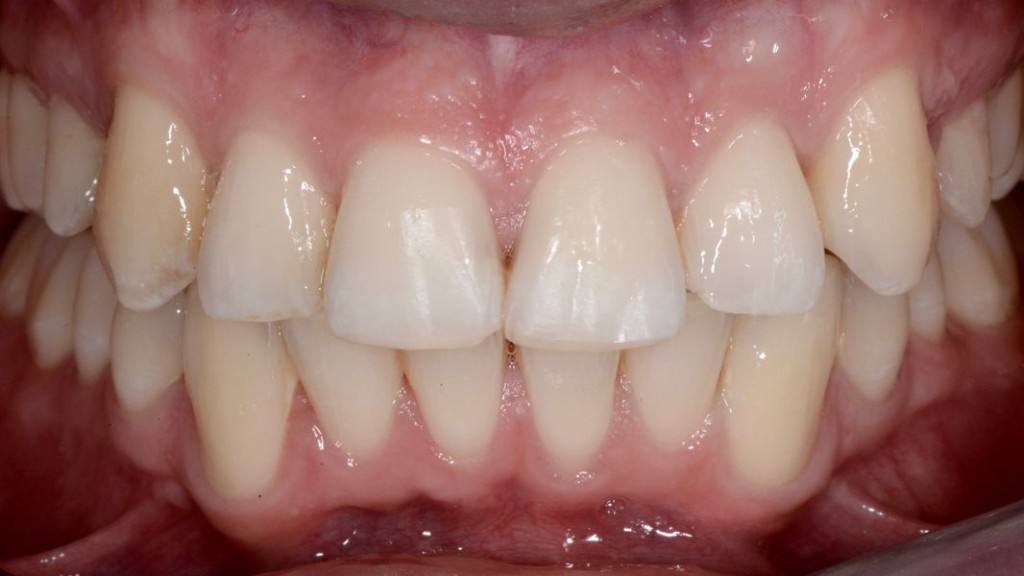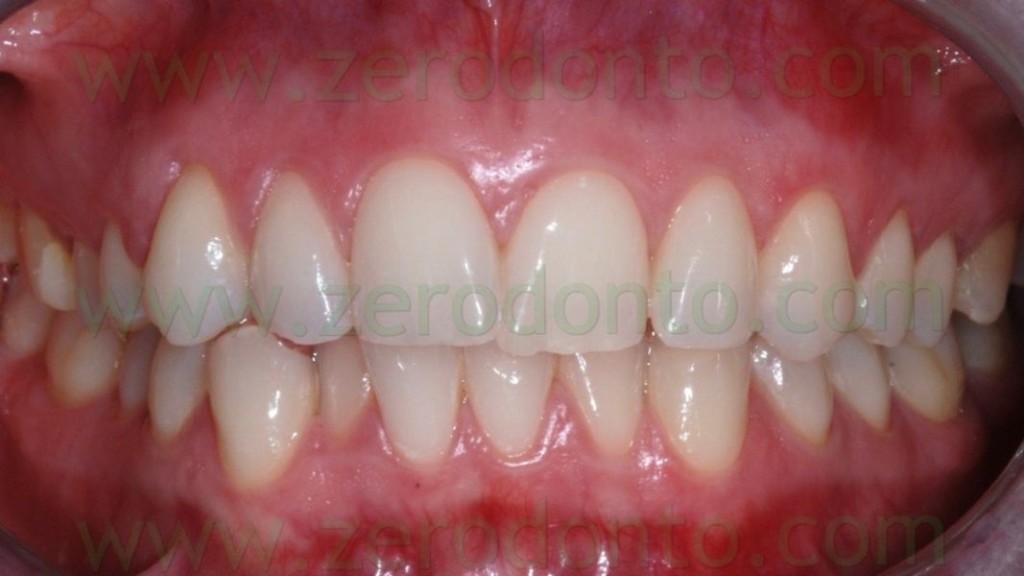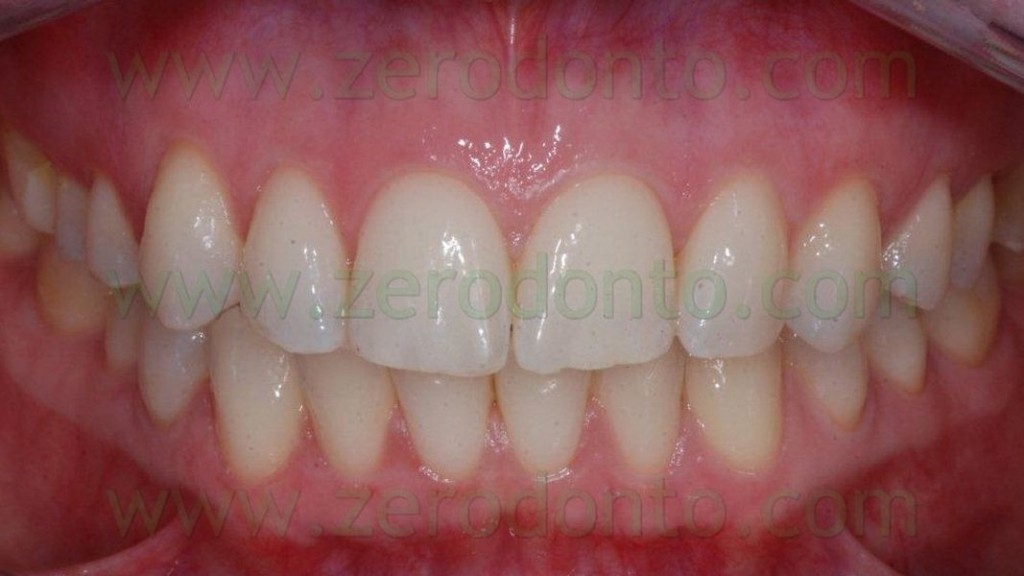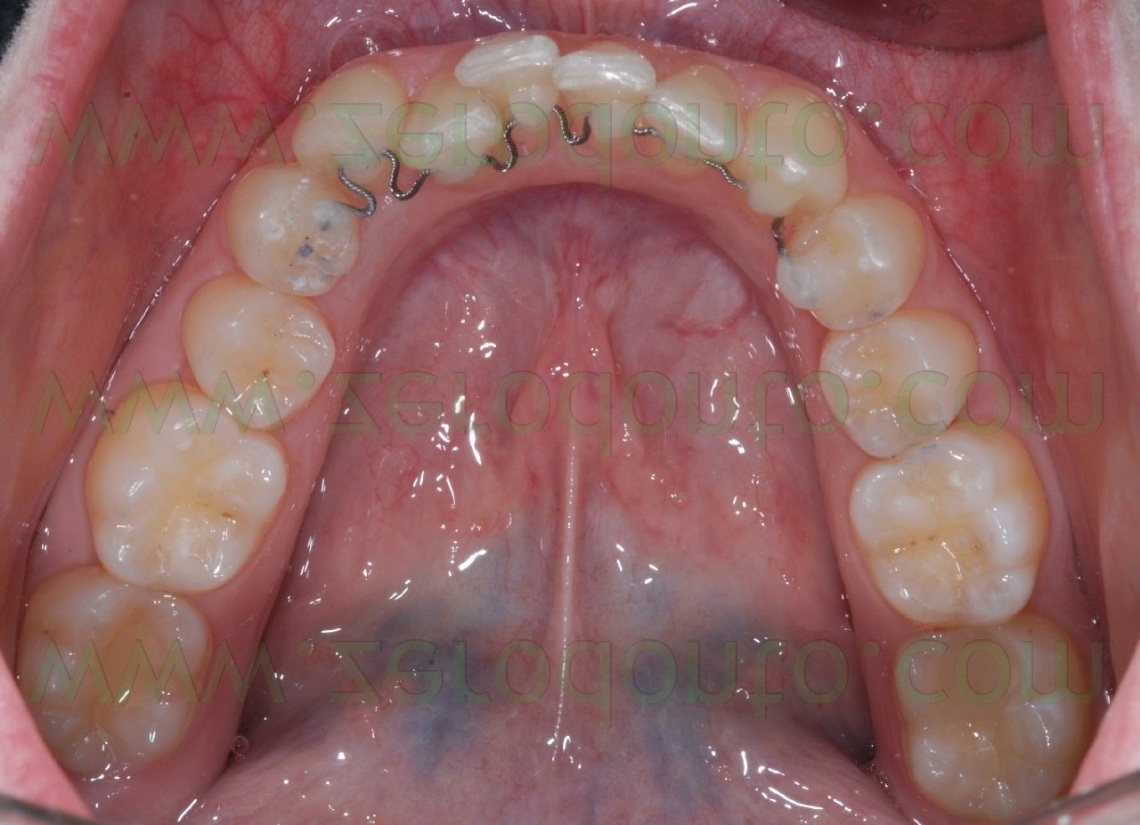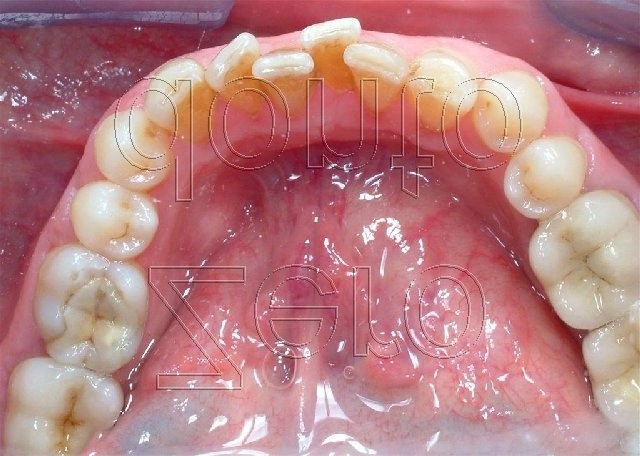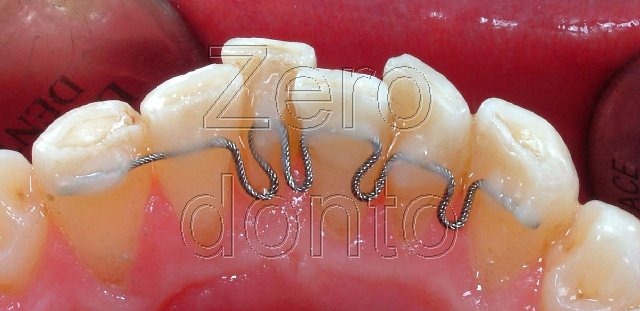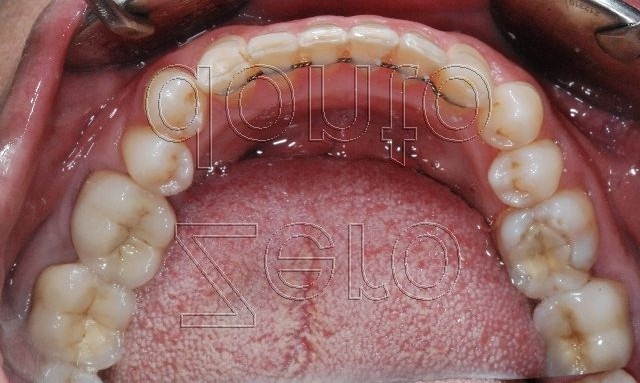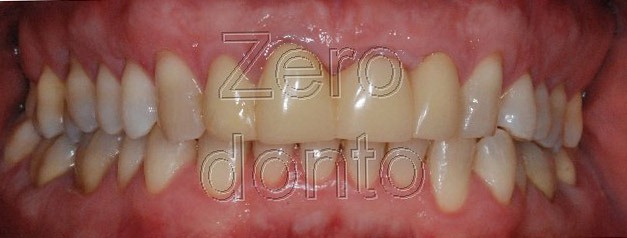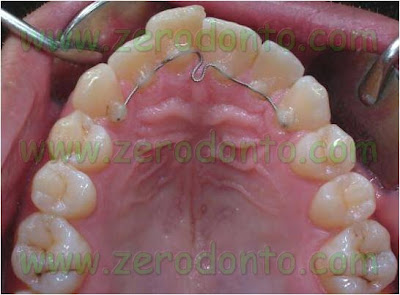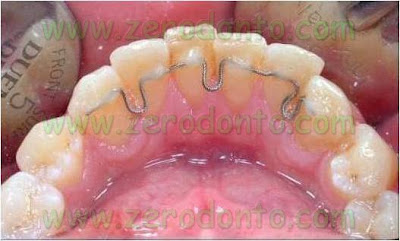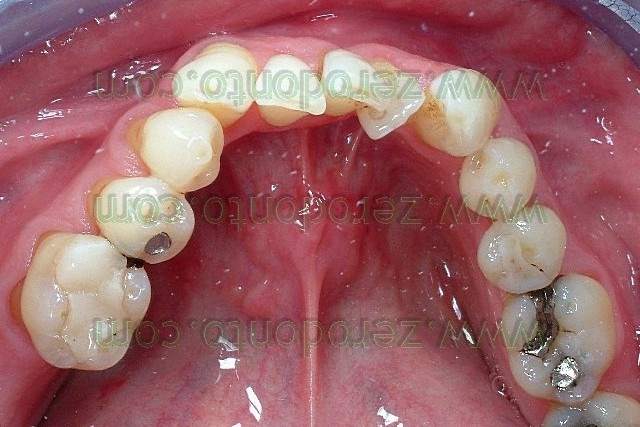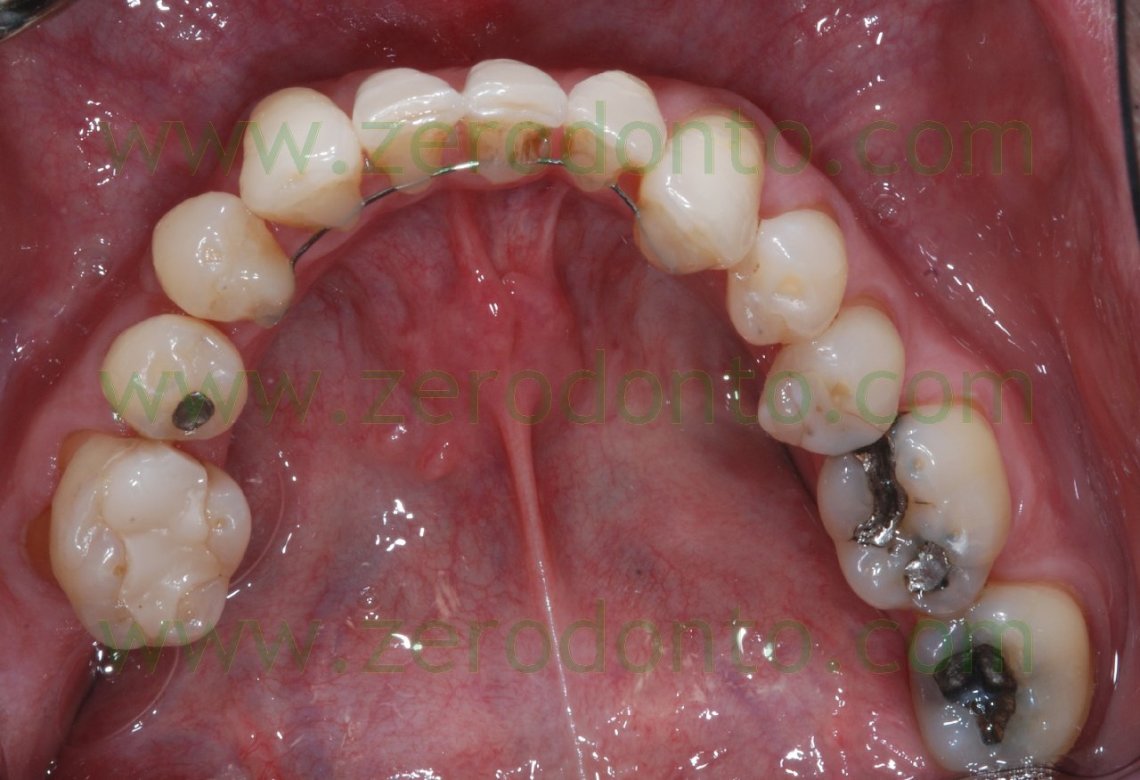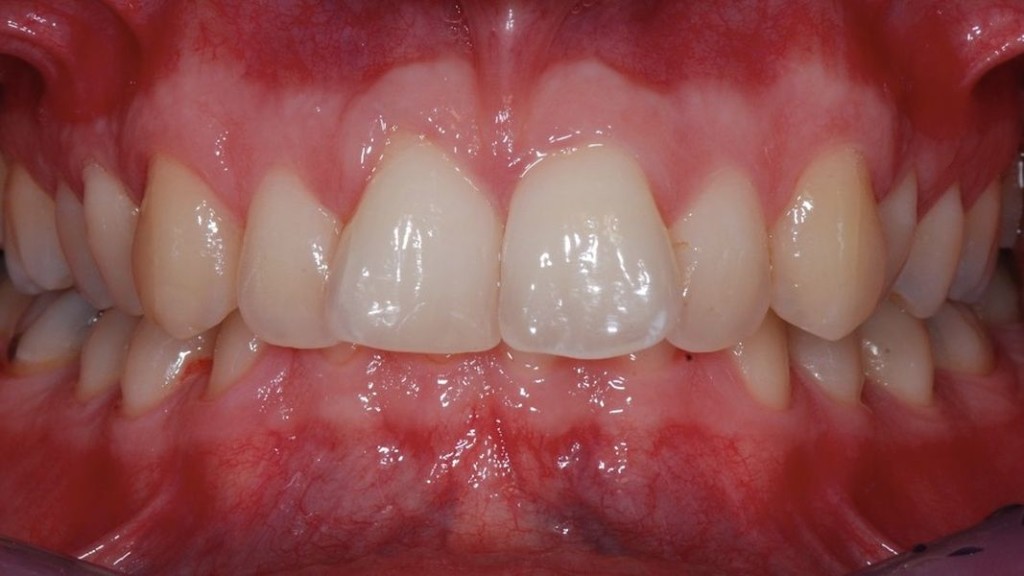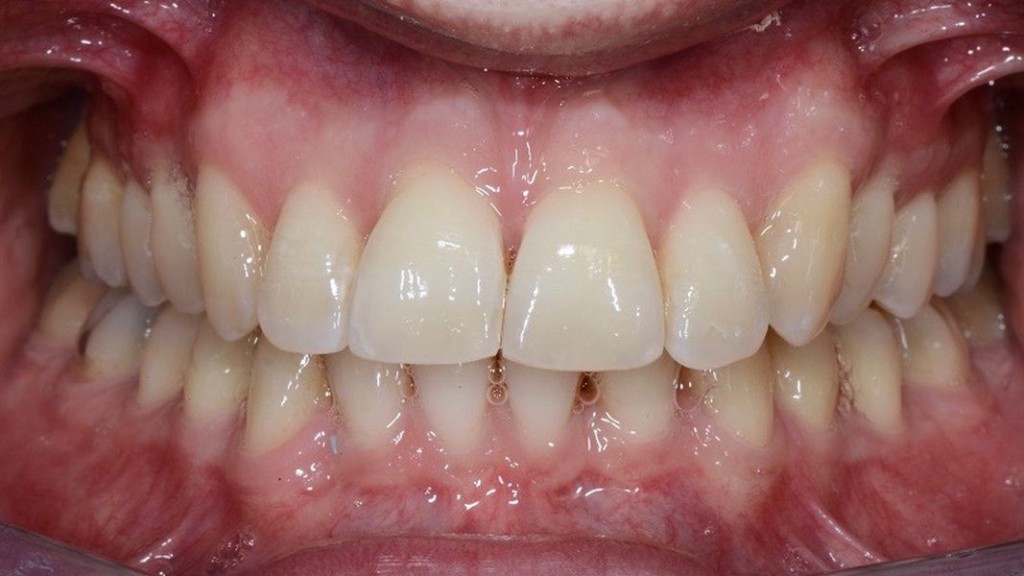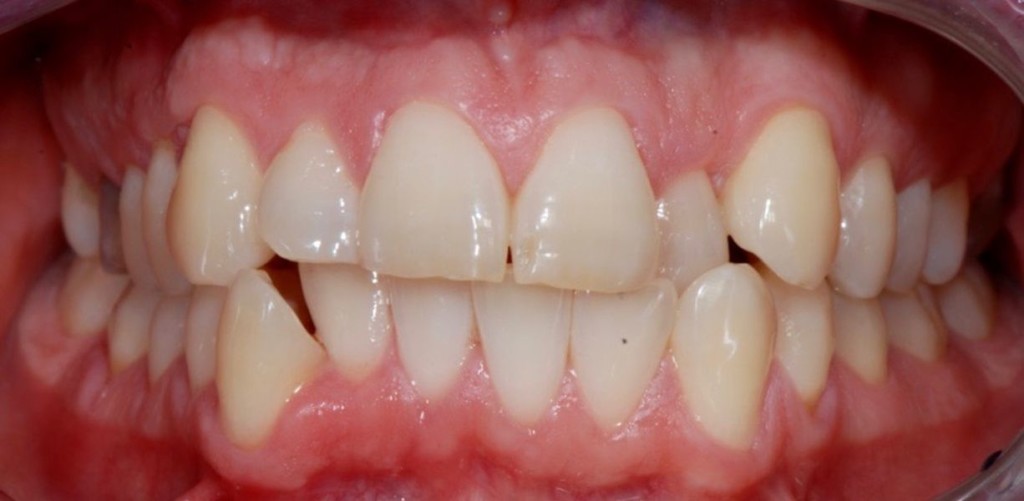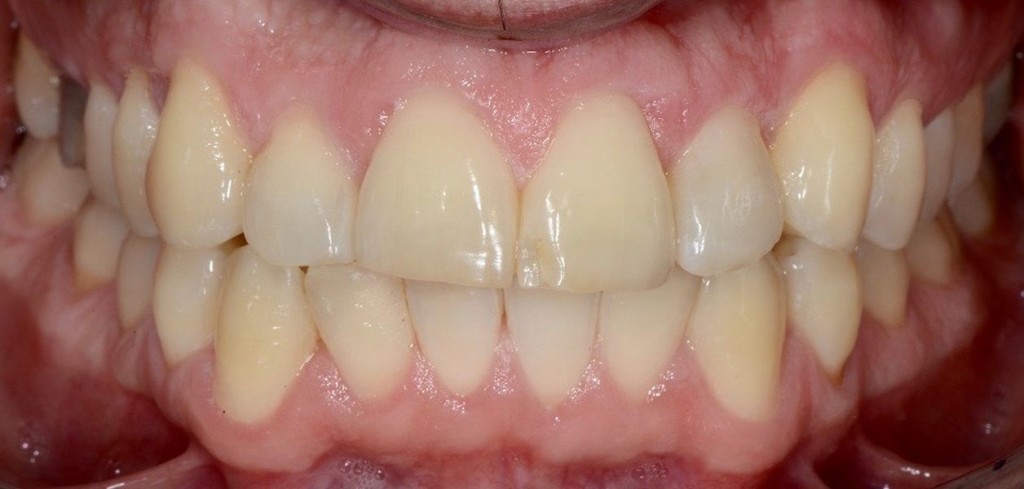Invisible Lingual Orthodontics represents an innovative approach to Orthodontics, which it keeps principles and purposes (diagnosis, prevention and rehabilitation of dental malocclusions) from. Differently from traditional Orthodontics, Invisible Orthodontics does not use classic appliances made up of metal and ceramic brackets, that can cause anxiety and embarassment to patients because of their visibility, but only very thin wires applied on internal dental surfaces.
It’s the orthodontic treatment most requested by those patients that are particularly aesthetics and comfort-conscious. This is due to the fact that, in addition to being totally invisible, it is currently the thinner appliance ever produced, as you can see from the following explanatory video.
Orthodontic appliance with metal or ceramic buccal brackets is more visibile and bulky, unlike invisible bracketless orthodontics.
This innovative technique has been described in a book published by Dr. Anna Mariniello and Dr. Fabio Cozzolino for an international specialistic editor (Atlas of Bracketless Fixed Lingual Orthodontics, Quintessenza Edizioni). The adhesive technique is the same used for conventional devices with brackets (both vestibular and lingual); once the therapy is completed, the appliance is removed and the dental surfaces recover the same aspect they had before the treatment, without any change of shape and color. Differently from lingual brackets, that also allow to perform invisible treatments, complaints related to the tongue and phonetic alterations are rare events and always limited to the first hours after the application of the devices.

Although they are not visible, lingual brackets have higher thicknesses compared to bracketless orthodontics and they can cause lingual complaints and phonetic alterations.
This is due to the fact that the appliances are thinner and do not present protuberances that could injure the tongue. The treatment time and quality of results can be compared to other traditional therapies with brackets and it is possible to treat any kind of malocclusion (I, II e III class of Angle, open bite, deep bite, etc)). Generally, it is referred to invisible orthodontics talking about transparent templates and aligners. This is not a correct definition as it should be better to name such treatments as esthetic orthodontics, since aligners are visible in any case, even if less evident than ceramic or metal vestibular brackets.

The aligners are less visible compared to metallic or ceramic vestibular brackets and create the optical effect of a transparent film visible on the teeth
Numerous scientific studies, documented in literature, have been conducted on invisible aligners (bibliographical references and links further down this page).
Djeu G, Shelton C, Maganzini A. (Outcome assessment of Invisalign and traditional orthodontic treatment compared with the American Board of Orthodontics objective grading system) showed that invisible aligners “did not treat malocclusions as well as braces”. Uribe F, Cutrera A, Nanda R (A segmented appliance for space closure followed by Invisalign and fixed appliances.) assert that the aligners are deficient in their “ability to correct large anteroposterior discrepancies and occlusal contacts”.
Giancotti A, Greco M, Mampieri G (Extraction treatment using Invisalign Technique) say that with the invisible aligners “the space closure achieved with crown tipping and without correct root inclination making a further fixed appliance phase necessary”. According to Uribe F, Cutrera A, e Nanda R, this fixed appliance phase may also be necessary due to the limitations of transparent aligners “in achieving rotational and vertical movements”.
Studies carried out by Kuncio D, Maganzini A, Shelton C, and Freeman K (Invisalign and traditional orthodontic treatment postretention outcomes compared using the American Board of Orthodontics objective grading system.) demonstrate, in their group of patients, that those treated with the aligners “relapsed more than those treated with conventional fixed appliances”.
Studies by Nedwed V and Miethke RR show that patients accept more easily be treated with masks that with lingual brackets because they consider the therapy less annoying.
Invisible Orthodontics was presented by Dr. Anna Mariniello on national and international orthodontic meetings (World Society of Lingual Orthodontics, European Orthodontic Society, Italian Orthodontic Society) and it has been published on specialistic journals
Furthermore, it has been widely described in the Invisible Orthodontics section of the dental blog Zerodonto.
How invisible Bracketless Orthodontics is performed The treatment is done using 1 mm-thick wires, directly attached to the lingual surfaces of theet, eliminating the room of the brackets.
The most used wires are the steel wires generally used to make passive retainers (lingual fixed devices, that are often applied on teeth after orthodontic alignments to keep the results over time).
These wires have to be modeled to achieve the desired dental movements.
The modeling is extremely precise and personalized, since it depends not only on the malocclusion but also on the shape and position of teeth.
 The adhesion of the appliance is the same as conventional othodontics and it does not cause any pain to the patient.
The adhesion of the appliance is the same as conventional othodontics and it does not cause any pain to the patient.
The dental surface is prepared for adhesion using an etching gel; then, a bonding agent is applied and the wire is fixed using a flowable composite, that becomes solid thanks to a curing light.
The device is so thin and follows so strictly the dental anatomy that it seems to pass through grooves made on the inner aspects of the teeth, but the surfaces are left completely intact.
The wire is precisely adapted to the lingual surfaces with no alteration of the morphology and function. During the recall appointments, it is necessary to reactivate the device detaching it from some teeth (it is always a painless procedure for the patient) or it can be necessary to change the wire, just as it happens in traditional treatments with brackets.
The resolution of some malocclusions could require tooth extractions, usually the first or second premolars or milky teeth, in case of missed eruption of the equivalent permanent tooth.
The absence of these teeth will never be noticed since temporary resin teeth, very similar in shape and color to the natural ones, are attached to the appliance.
These provisional restorations will be removed when the space is closed after the movement of other teeth. 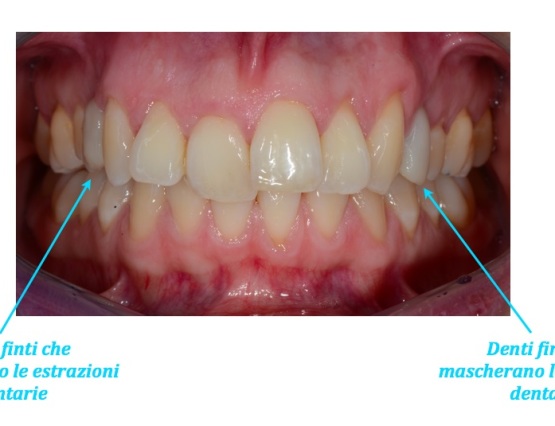
References
1-Am J Orthod Dentofacial Orthop. 2014 Oct;146(4):411.
Simon M, Keilig L, Schwarze J, Jung BA, Bourauel C.
2- Angle Orthod. 2014 Nov 20.
Efficacy of clear aligners in controlling orthodontic tooth movement: A systematic review.
Rossini G, Parrini S, Castroflorio T, Deregibus A, Debernardi CL.
3- Orthodontics (Chic.). 2011 Winter;12(4):386-95.
A segmented appliance for space closure followed by Invisalign and fixed appliances.
Uribe F1, Cutrera A, Nanda R.
4- Am J Orthod Dentofacial Orthop. 2009 Jan;135(1):27-35. doi: 10.1016/j.ajodo.2007.05.018.
Kravitz ND, Kusnoto B, BeGole E, Obrez A, Agran B.
5- Angle Orthod. 2007 Sep;77(5):864-9.
Kuncio D, Maganzini A, Shelton C, Freeman K.
6- Prog Orthod. 2006;7(1):32-43.
Extraction treatment using Invisalign Technique.
Giancotti A, Greco M, Mampieri G.
7- J Am Dent Assoc. 2002 Mar;133(3):369-71.
Orthodontics and the general practitioner.
Christensen GJ.
8- J Orofac Orthop. 2005 Mar;66(2):162-73.
Motivation, acceptance and problems of invisalign patients.
[Article in English, German]Nedwed V1, Miethke RR.
9- Am J Orthod Dentofacial Orthop. 2005 Sep;128(3):292-8; discussion 298.
Djeu G, Shelton C, Maganzini A.
More articles and clinical cases on Invisible Orthodontics
FREQUENTLY ASKED QUESTIONS
-
Why to perform orthodontics in adult age?
In the last years, the request for dental alignment therapies from adult patients has surprisingly increased. The raising focus on esthetics and the awareness that a beautiful smile has a great value for the harmony of the face and for the increase of self-esteem is one of the reason of such a phenomenon, but not the only one.
It is now well-known that misaligned teeth cannot be cleaned in a correct way; plaque and tartar accumulation is a consequence of this condition and contributes to the onset of gingival inflammations that, if not treated, can cause periodontal disease with loss of the bone sorrounding the teeth. Scientific studies proved that tartar not only causes damages at a local level, but even at a systemic one. The increase of bacteremia that is present in patients affected by periodontitis is correlated to an increase of cardiovascular illnesses. Abnormal dental contacts due to malocclusions facilitate the onset of parafunctions, such as bruxism, which can cause dental wear or increased mobility.
A correct dental alignment also enhances the mastication, the first and one of the more important factors allowing for a proper digestion.
So it is clear that orthodontic therapies play a fundamental role not only for esthetics or periodontal health, but also for the general health of our organism as well as for a complete psychophysical wellness.
-
What is lingual bracketless Orthodontics?
Lingual bracketless orthodontics is an innovative technique that allows for the resolution of dental malocclusions with appliances that, apart from being invisible, are extremely convenient for the tongue and the mucosae, being nowadays the most thin available device. This technique requires the use of orthodontic wires directly attached to the lingual surfaces of the teeth, without the application of brackets, avoiding their thickness and obstruction. The used dental adhesives have identical properties to those used to bond the brackets and they do not cause any damage to the teeth.
-
What kind of malocclusions can lingual bracketless orthodontics treat?
Every kind of tooth malocclusion can be treated with lingual bracketless orthodontics, that is to say Angle’s first, second and third class malocclusions, characterized by excess and defect dento-basal disharmony.
-
Why is it so important to have aligned teeth?
Having aligned teeth presents various advantages. First, it gives the possibility to clean teeth in a correct way and so reduces the risk of caries and bone loss, contributing to improve people’s health. Important studies proved that the tartar present in the oral cavity causes an increase of bacteraemia with the consequent hardening of the arteries and a high risk of heart attacks and strokes. Having aligned dental arches favors the correct movements of the temporo-mandibular joint, reducing cervical pains and headaches, often caused by bad dental occlusion. Another undeniable advantage is that dental alignment reduces non functional tooth contacts causing dental wear and abrasions. Dental malpositions can also favor the onset of parafunctions, such as bruxism, that contribute to weaken the periodontal support, aggravating dental wear and bone loss. Last but no least, perfectly aligned teeth improves esthetics, that is often the main cause that leads patients to start the treatment. A beautiful smile contributes to increase the phsychological wellness.
-
Are there any age limits to teeth repositioning?
No, since the repositioning of the teeth is possible at any age.
-
How many kinds of orthodontic treatments do exist?
There are many kinds of orthodontics and they can be classified in 2 main categories: fixed and removable treatments. Removable ones are put on and removed by the patients themselves to eat or to brush teeth. An example is provided by invisible aligners, that are effective only in performing limited movements and are not as precise as fixed apliances. Thr removable devices are also slower than the fixed ones and the irregular forces applied on the teeth can weaken the periodontal support. Differently, the use of removable functional orthodontics is very useful in children and teenagers, since their shape and function do not allow to use the mas fixed devices. This kind of orthodontic appliances have orthopedic purposes that ease and modify bone development in case of skeletal disharmony and control bad habits which can cause changes in tooth and skeletal development; such appliances can be effective only in restricted age ranges (from 9 to 11 year-old). Fixed orthodontics are the most successful on permanent teeth and so in adults. They can be divided in vestibular and lingual devices. The first ones are applied on the external surfaces of the and so they are visibile. They can be made up of metal or ceramic.
Lingual appliances are invisibile and can be used with or without brackets. Those without brackets are really comfortable because they are the thinnest orthodontic devices nowadays available. They also offer a huge comfort for patients thanks to a therapy that is invisibile and completely tolerated by the tongue and the mucosae; they are adapted to tooth anatomy and do not cause any phonetic alteration. On the other hand, lingual orthodontics with brackets have wider thicknesses and require longer times of adaptation; frequently, it is necessary to protect the teeth with sticky wax, in order to prevent the contact with the tongue and limit phonetic alterations. -
What age is it necessary to be subjected to an orthodontic therapy from?
It is possible to start when you are 4-5 year-old. Essentially, we are talking about visits for preventive purposes, because it is very difficult to have to treat children at such a young age, unless serious dental or skeletal abnormalities are evidenced. However, there are some bad habits that influence the skeletal-dental development (e.g. the kind of breathing and swallowing) that, if highlighted and corrected, prevent children from the future necessity to be submitted to an orthodontic therapy.
-
How long does an orthodontic therapy last?
The treatment lasting depends on the severity of the malocclusion that has to be treated. It is very variable, ranging between a few months to about 3 years.
-
How many check-ups do the patient necessitate during the orthodontic therapy?
Usually the patient has to be monitored once per month.
-
Why in some cases is it necessary to join the orthodontic therapy to the maxillo-facial surgery?
Sometimes it is necessary because some kinds of malocclusions are characterized by maxillary and/or mandibular skeletal disharmonies that can only be corrected with surgerical procedures.
-
Does the obtained result after the therapy last all life long?
At the end of an orthodontic therapy it is necessary to perform a maintenance phase (called “restraint”) that can be made using removable night appliances or lingual fixed orthodontics made up of passive retainers applied on the lingual surfaces of anterior teeth. This phase can last for 2 to 3 years, due to the seriousness of the malocclusion, and during this period the patient has to be followed-up every 4-6 months. However, it is recommendable to be checked-up by the dentist at least once per year, since the position of teeth is influenced by many factors, such as bruxism and bad habits (e.g. nail eating, mouth breathing, bone loss, traumas) and can always change, but it is possible to correct any alteration if early intercepted.
-
Does orthodontics damage the teeth?
No, it does not. At the end of the therapy, the dental adhesives used to make the ortohodnotic brackets adhere on tooth surfaces are selectively removed by means of dedicated burs that do not damage dental enamel.
-
Does orthodontics increase the risk of decay?
Noi, orthodontics by itself does not decay teeth but it surely necessitates a better home oral hygiene maintenance. This is due to the inevitable room taken up by the orthodontic, devices that could favor plaque accumulation that, if not removed, turns into tartar. However, the patients are always monitored by the dentist, who will give them all the indications to clean the teeth correctly and will estabilish possible professional tooth cleaning sessions, in order to keepgood periodontal health.
-
Is orthodontics painful?
The pressure exerted by orthodontic appliances does not cause pain but tension, due to the activation of the periodontal receptors. This kind of sensation is felt every time the orthodontic devices are activeted (usually once per month) and it gradually fades till it completely disappears in 2-3 days, thanks to the adaptation of periodontal receptors.
-
Can an orthodontic therapy be done in the presence of crowned teeth?
Yes, it is possible to apply orthodontic devices on prosthetic crowns, because they move exactly like sound teeth.
-
Can an orthodontic therapy be done in the presence of implants?
Yes, but only to reposition natual teeth, since implants cannot change their position beacuse of osseointegration.
-
Can an orthodontic therapy be done in case of missing teeth?
Yes, it is possible and sometimes it is necessary because, in the presence of missing teeth, the remaning elements can change position, moving in an uncontrolled way into the spaces deriving from the absence of teeth. Such movements often make oral hygiene more difficult and can create anomalous contacts between teeth with altered occlusion and joint problems. The orthodontic therapy restores correct dental positions, that is necessary even for the creation of proper spaces for implant insertion or for the placement of prosthetic devices substituting missing teeth.
-
What factors do I have to evaluate to understand if I have the necessity to subjected to an orthodontic therapy?
The main factors to be considered are the presence of crowding, rotated and/or inclined teeth, spaces between teeth and dental wear. However, uncorrect occlusal contacts between dental arches (that can cause joint and muscle problems with the onset of headaches and neck pain) are not always detectable byd the patient.
-
Can an orthodontic therapy be done in the presence of periodontitis?
Yes, but only if patients are under periodontal control and the periodontitis is not in active phase.
Atlas of Bracketless Fixed Lingual Orthodontics
Anna Mariniello – Fabio Cozzolino
Editor: Quintessenza Edizioni
The increasing demand for invisible and comfortable orthodontic therapies has encouraged the innovation of brackletless lingual orthodontic treatment, which is accomplished by adapting orthodontic wires to the arch and bonding them directly to the lingual surfaces of the teeth. The authors demonstrate the use of this innovative technique in clinical cases of increasing complexity, from Class I malocclusions to the correction of Class III relationships, bilateral crossbites, and deep and open bites. Cases include analysis of treatment with and without extraction. Bone regeneration by means of orthodontic movements is also discussed.Click here for more info or to order the book
Contact us for any questions.
Clinical Cases
Clinical Case 1: Malocclusion characterized by a severe anterior open bite
Clinical Case 2: Angle’s second class malocclusion, characterized by crowded teeth
Clinical Case 3: Canine third class malocclusion, characterized by crowded teeth.
Clinical Case 4: Angle’s second class malocclusion, characterized by crowded teeth, treated with extractions.
Clinical Case 5: Malocclusion characterized by a canine included in the bone.
Clinical Case 6: Clinical procedures to apply active retainers.
Clinical Case 7: Treatment of crowded mandibular arch and deep bite
Clinical Case 8: Case of crowded teeth and protrusion of maxillary teeth.
Clinical Case 9: Crowded and protruded maxillary teeth.
Clinical Case 10: Invisible orthodontics in case of severe mandibular crowding.
Clinical Case 11: Malocclusion characterized by a deep bite.
Clinical Case 12: Malocclusion characterized by cross bite and crowding at both arches.
Clinical Case 1: Malocclusion characterized by a severe anterior open bite
A female adult patient wanted to solve the lack of contact and protrusion of her theet.
A conventional visible appliance with brackets would have caused a considerable embarassment, while the application of a lingual device with brackets, even though not visibile, made her anxious because of the risk of fastidious irritations of the tongue as well as phonetic alterations. Therefore, the therapy was realized using lingual bracketless orthodontics, nowadays the most thin appliance available.
Clinical Case 2: Angle’s second class malocclusion, characterized by crowded teeth
The therapy was performed using invisible lingual bracketless orthodontics, with the application of intermaxillary rubbers, that the patient puts on by himself.
The hooks for the rubbers, attached on the external surfaces of the teeth in order to make their application easier for the patient, in visible areas were realized with ceramic material, so that they were completely camouflaged.
Clinical Case 3: Canine third class malocclusion, characterized by crowded teeth.
Invisible orthodontics is used together with intermaxillary rubbers that the patient puts on by himself.Simultaneously to dental arch alignment, it was performed the correction of the canine class relationship.
Clinical Case 4: Angle’s second class malocclusion, characterized by crowded teeth, treated with extractions.
To correct the malocclusion, it was necessary to extract superior premolars. The therapy was done by means of invisibile lingual bracketless orthodontics and the dental extractions were not evident thanks to the presence of fake resin teeth attached to the lingual appliance.These teeth were worn till they were completely removed when the space created by the extractions was filled up by the remaining aligned teeth.
Clinical Case 5: Malocclusion characterized by a canine included in the bone.
Malocclusion characterized by a canine included in the bone.An adult patient presented with a milky canine in the maxillary arch, while the permanent tooth was included in the bone. The therapy was done in a completely invisibile way through the use of lingual bracketless orthodontics. The extraction of the milky canine and the postioning of the hook on the included tooth were performed under local anesthesia, in a completely painless way for the patient.
The space obtained from the extraction of the milky canine was masked with a fake resin canine, kept in place till the permanent tooth was correctly placed in the arch.
Clinical Case 6: Clinical procedures to apply active retainers.
A 28-year old female patient presented with maxillary crowded teeth, the right canine in ectopic position and the mandibular midline moved on the right side.The patient requested for a comfortable and invisible therapy, without phonetic alterations and problems to the gums. Therefore, the malocclusion was treated with lingual bracketless orthodontics.
After the application of the retainers, the patient was monitored every 3-4 weeks.
Dental alignment was obtained after about 10 months, with complete satisfaction of the patient. Then, the active retainers were substituted with passive ones.
Clinical Case 7: Treatment of crowded mandibular arch and deep bite
The patient wanted to align the mandibular arch, asking for an invisible and painfree therapy; it was performed with the lingual bracketless technique together with pre-activated retainers.One month after, the crowding was significantly reduced. The patient was monitored every 3-4 weeks.
When the alignment was completed, the active retainer was substituted with a passive one.
Thanks to this innovative technique, the patient was satisfied because of the absence of tongue and gum complaints as well as the invisibility of the orthodontic appliance.
Clinical Case 8: Case of crowded teeth and protrusion of maxillary teeth.
The patient was motivated to align his teeth with an esthetic and inivisible orthodontic therapy.The patient presented with crowded teeth and a severe protrusion of the maxillary incisors.
It was applied an active retainer to both arches from canine to canine; the patient was monitored every 3-4 weeks and the wires were detached every time in the area where the activation was necessary. The maxillary alignment was achieved in about 2 monts, while the mandibular one in 6 months. The esthetic result was excellent.
Clinical Case 9: Crowded and protruded maxillary teeth.
Very complex case of a 62 year-old patient, with a severe crowding at the mandibular arch and treated and stabilized periodontal disease.Despite the habitual sessions of oral hygiene, the patient could not keep the front mandibular teeth clean because of their malposition. Moreover, he did not want a visibile and annoying treatment.
Consequently, it was proposed an insivible orthodontic therapy with active retainers. The alignment was obtained after 10 months, performing a slow repositioning of the teeth and frequent sessions of tartar removal.
The final outocome was excellent, particularly considering the severe initial condition.
Clinical Case 10: Crowded and protruded maxillary teeth.
Case of a patient with severe mandibular crowding and difficult oral hygiene maintenance.The patient requested for an invisible and painfree therapy; consequently, a lingual bracketless treatment was chosen. The patient was monitored every 3 weeks and the treatment lasted about 1 year. When the alignment was obtained, a passive retainer was applied.





















